What is the Purpose of Orthodontic Treatment?
The purpose of orthodontic treatment is to bring teeth, jaws, lips and face into proportion. Well aligned dental and facial components promote oral health and function (biting, chewing, speaking and breathing), and as an added bonus, create an attractive smile.
What is a Malocclusion or a “Bad Bite”, and What Are the Benefits of Orthodontic Treatment?
The popular belief that orthodontic treatment is purely cosmetic in nature could not be further from the truth. Orthodontic treatment plays a larger role in healthcare and overall well-being than is generally believed.
Incorrect position of the teeth, jaws or both is described as a malocclusion, or a “bad bite”. When teeth or jaws are not properly aligned, they cannot function as nature intended. If left untreated, a malocclusion can lead to premature aging and wear of the teeth, periodontal (gum) disease, higher incidence of tooth decay, TMJ problems, unbalanced facial features, respiratory and speech problems.
These complications may result in chronic pain in the face and neck, as well as persistent headaches.
An attractive smile can have emotional benefits too. Self-confidence and self-esteem may improve as orthodontic treatment brings teeth, lips and face into proportion.
What Type of Problems Can Be Treated with Orthodontics?
Overbite (deep bite)
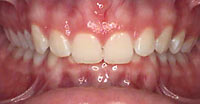
If not corrected, the front teeth usually show signs of premature wear and chipping that can vary in severity. If the lower teeth are biting into the roof of the mouth, they can damage the gum tissue covering the back of the upper teeth.
Overbites can cause tension of the chewing muscles and create abnormal forces on the TMJ. Patients may experience jaw joint pain, clicking and popping noises in jaw joints when opening or closing the mouth.
Overjet (Upper Front Teeth Protrusion)
Overjet refers to the horizontal relationship between the upper and lower front teeth. It is diagnosed when the upper teeth are extending too far forward, or the lower teeth are not extending far enough forward, creating an excessive horizontal distance between the two.
The appearance and function of your teeth are impacted by this type of bite.
The association between upper front teeth protrusion and traumatic dental injuries to anterior teeth is well documented. It also affects chewing efficiency, causes premature wear of posterior/back teeth, and may increase the incidence of sleep apnea in cases where the lower jaw is not extending far enough forward.
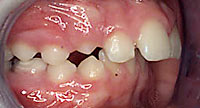
Cosmetic concerns include the ‘buck tooth” appearance, small or detruded chin, inability to properly close lips over the teeth and lower lip that curls excessively under the upper teeth.
Openbite
Openbite refers to the lack of vertical overlap between the upper and lower front teeth. It is diagnosed when the teeth do not meet, and there is a visible opening between them.
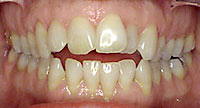
This type of bite causes improper function of anterior and posterior teeth, with the front teeth not touching at all, and the back teeth being overworked. Such bites can lead to premature wear of posterior teeth, damage to the enamel of the back teeth along the gum line, gum recession, jaw joint pain and issues, inability to bite into food, speech problems and development of oral habits such tongue thrust.
Of all malocclusions, open bites have the highest association with TMJ problems.
Open bite can also occur between the back teeth, with only the front teeth touching when the mouth is fully closed. Posterior open bites rarely occur in nature but can be caused by improper outcome of Invisalign® treatment or do-it-yourself orthodontics.
Crossbite
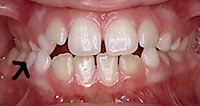
Crossbite can lead to excessive trauma and sensitivity of the teeth involved, abnormal wear or chipping, periodontal problems including loose teeth and gum/bone loss. Patients often report increased biting of own lips and cheek when eating or talking.
It is preferable to treat crossbites as early as they are noticed. If left untreated in growing children, it can lead to an array of dental and skeletal issues, including visible facial (chin) asymmetry.
Crowding

Besides being an esthetic concern, crowded teeth can cause difficulty in properly brushing and flossing. There is a higher incidence of tooth decay/caries, inflamed and bleeding gums, tooth discoloration in crowded areas, receding gums and loose teeth.
Edge to Edge Bite
Such relationship almost always leads to excessively short and worn-down front teeth. Oftentimes, if the wear has already occurred and the patient seeks restorations (veneers), orthodontic movement will be required first in order to move teeth out of harm’s way, and ensure longevity of dental restorations.
Spacing/Gaps
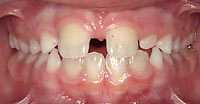
In adult dentition, gaps may only be a cosmetic or aesthetic concern, but they could also lead to several functional issues and possible food impaction between the back teeth in particular.
Spacing is desirable between the baby teeth. It is nature’s way to account for the larger size of the permanent teeth that are yet to grow in. Lack of gaps between baby teeth is an indication of future crowding in adult dentition.
Dental Midlines Not Matched
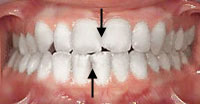
Over-Retained Baby Teeth
Potential complications of over-retained baby teeth are ectopic eruptions of permanent teeth (teeth erupting in the wrong place, such as roof of the mouth or the side of the cheek) or impaction (teeth unable to break through the gum and remaining within the bone).
Premature Loss of Baby Teeth
Primary teeth help your child to chew, speak and smile, but they also have another very important job. They hold space in the jaws for permanent teeth that are growing under the gums and guide them into their proper position. When a primary tooth is lost too early, the neighboring teeth can drift into the empty space and make it difficult or impossible for the growing adult tooth to find room to come in.
If a baby tooth is lost too early, the space can be maintained with an orthodontic appliance. Simple space maintenance can avoid a lengthy and complex orthodontic treatment.
Sometimes, the space needs to be regained before it can be maintained. In those cases, a short Phase I treatment may be needed.
Premature Loss of Baby Teeth
An “impacted” tooth is a tooth that cannot grow in because it does not have enough room or may be heading in the wrong direction or position.
The most common teeth to become impacted are wisdom teeth. However, other teeth that are more important in the structure and functions of the mouth may get impacted too. It is often the case with upper canines (eye teeth). Instead of extracting them like wisdom teeth, an effort must be made to bring them into their proper position.
Treatment of impacted teeth ranges from relatively simple to complicated, depending on the stage of dental development at the time the problem is found. If intercepted early, extracting a baby tooth may be all that is needed to correct the problem. However, later treatment of this clinical entity usually involves surgical exposure of the impacted tooth, followed by orthodontic traction to guide and align it into the proper position.
Early diagnosis and intervention can save time, expense, and avoid more complex treatment in the permanent dentition. The old adage “a stitch in time saves nine” certainly applies here. To this end, the American Association of Orthodontists® recommends that children get an orthodontic check-up no later than age 7.
If left untreated, an impacted tooth can harm the neighboring teeth or cause them to move into unhealthy positions. Formation of cysts around impacted teeth has also been reported in the literature.
Supernumerary Teeth and Congenitally Missing Teeth
Children have 20 baby teeth and adults have 32 permanent teeth, including wisdom teeth. If additional to the normal number of teeth form, they are called supernumerary teeth. If a tooth fails to form, it is said to be congenitally missing.
Both conditions may give rise to a variety of clinical problems. Most supernumerary teeth need to be extracted as they cause undesired crowding of the teeth. The remaining teeth are then straightened, and the proper dental function is established.
With the exception of the wisdom teeth, the most common missing adult teeth are upper lateral incisors (teeth on either side of the two front teeth), and lower second premolars (fifth tooth from the midline). Besides the obvious cosmetic concerns, missing teeth may pose functional adversity, such difficulty with speaking and chewing.
Several treatment options are available to address the missing teeth, and the ideal solution is dependent on many different, individual factors. What may work for one patient may not be advisable for another.
If you would like to learn more about treatment options, schedule a complimentary consultation, and we will provide you with a solution that is best fitting for your particular situation.
Peg Laterals
Laterals are the two teeth located on either side of the two front teeth. When they do not develop correctly and appear small, pointed and resemble a grain of rice, they are called peg laterals. This term is specifically reserved for the under-developed adult teeth that grow in after the baby teeth have exfoliated. Because they play a tremendous role in the esthetics of the smile, malformed lateral incisors receive a great deal of attention, and can negatively affect one’s self-esteem.
Being smaller in size, peg laterals do not occupy as much space as they ideally should. As a consequence, the adjacent teeth are also out of place and in a much less healthy position, causing functional bite issues.
The ideal treatment consists of correcting the bite problem and creating ideal space for the restoration of the peg laterals. Commonly, peg laterals are treated using composite resin veneers in younger patients (white fillings), or porcelain veneers and crowns in adult patients.
If you need help designing your new smile, we have solutions for both kids and adults, including traditional metal braces, clear braces, champagne colored braces, and Invisalign. We have skills and experience to give you your best smile.
Expert Orthodontic Care
At Align Orthodontics, we are committed to diagnosing and treating common orthodontic problems with precision and care. Call us at 858-487-0173 to schedule a consultation with our orthodontist, Dr. Mirna Nguyen, for orthodontic care in Poway, California, and learn more about how we can help you achieve a confident and healthy smile!
